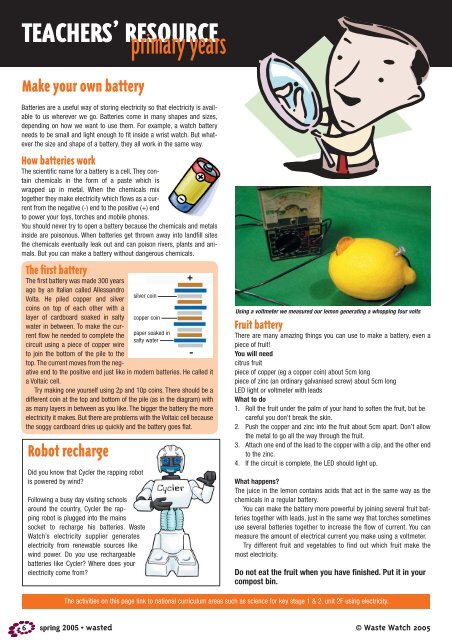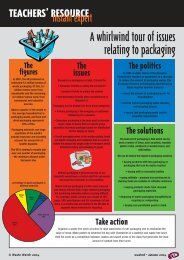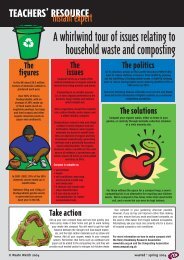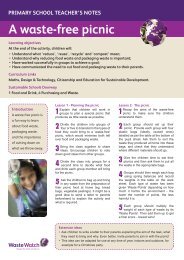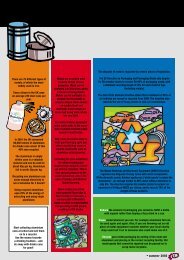Print 3889 WASTED NEWSLETTER 7 - Recyclezone
Print 3889 WASTED NEWSLETTER 7 - Recyclezone
Print 3889 WASTED NEWSLETTER 7 - Recyclezone
You also want an ePaper? Increase the reach of your titles
YUMPU automatically turns print PDFs into web optimized ePapers that Google loves.
TEACHERS’ RESOURCE<br />
primary years<br />
Make your own battery<br />
Batteries are a useful way of storing electricity so that electricity is available<br />
to us wherever we go. Batteries come in many shapes and sizes,<br />
depending on how we want to use them. For example, a watch battery<br />
needs to be small and light enough to fit inside a wrist watch. But whatever<br />
the size and shape of a battery, they all work in the same way.<br />
How batteries work<br />
The scientific name for a battery is a cell. They contain<br />
chemicals in the form of a paste which is<br />
wrapped up in metal. When the chemicals mix<br />
together they make electricity which flows as a current<br />
from the negative (-) end to the positive (+) end<br />
to power your toys, torches and mobile phones.<br />
You should never try to open a battery because the chemicals and metals<br />
inside are poisonous. When batteries get thrown away into landfill sites<br />
the chemicals eventually leak out and can poison rivers, plants and animals.<br />
But you can make a battery without dangerous chemicals.<br />
The first battery<br />
The first battery was made 300 years<br />
ago by an Italian called Allessandro<br />
Volta. He piled copper and silver<br />
coins on top of each other with a<br />
layer of cardboard soaked in salty<br />
water in between. To make the current<br />
flow he needed to complete the<br />
circuit using a piece of copper wire<br />
to join the bottom of the pile to the<br />
top. The current moves from the negative<br />
end to the positive end just like in modern batteries. He called it<br />
a Voltaic cell.<br />
Try making one yourself using 2p and 10p coins. There should be a<br />
different coin at the top and bottom of the pile (as in the diagram) with<br />
as many layers in between as you like. The bigger the battery the more<br />
electricity it makes. But there are problems with the Voltaic cell because<br />
the soggy cardboard dries up quickly and the battery goes flat.<br />
Robot recharge<br />
Did you know that Cycler the rapping robot<br />
is powered by wind?<br />
silver coin<br />
copper coin<br />
Following a busy day visiting schools<br />
around the country, Cycler the rapping<br />
robot is plugged into the mains<br />
socket to recharge his batteries. Waste<br />
Watch’s electricity supplier generates<br />
electricity from renewable sources like<br />
wind power. Do you use rechargeable<br />
batteries like Cycler? Where does your<br />
electricity come from?<br />
paper soaked in<br />
salty water<br />
+<br />
-<br />
Using a voltmeter we measured our lemon generating a whopping four volts<br />
Fruit battery<br />
There are many amazing things you can use to make a battery, even a<br />
piece of fruit!<br />
You will need<br />
citrus fruit<br />
piece of copper (eg a copper coin) about 5cm long<br />
piece of zinc (an ordinary galvanised screw) about 5cm long<br />
LED light or voltmeter with leads<br />
What to do<br />
1. Roll the fruit under the palm of your hand to soften the fruit, but be<br />
careful you don’t break the skin.<br />
2. Push the copper and zinc into the fruit about 5cm apart. Don’t allow<br />
the metal to go all the way through the fruit.<br />
3. Attach one end of the lead to the copper with a clip, and the other end<br />
to the zinc.<br />
4. If the circuit is complete, the LED should light up.<br />
What happens?<br />
The juice in the lemon contains acids that act in the same way as the<br />
chemicals in a regular battery.<br />
You can make the battery more powerful by joining several fruit batteries<br />
together with leads, just in the same way that torches sometimes<br />
use several batteries together to increase the flow of current. You can<br />
measure the amount of electrical current you make using a voltmeter.<br />
Try different fruit and vegetables to find out which fruit make the<br />
most electricity.<br />
Do not eat the fruit when you have finished. Put it in your<br />
compost bin.<br />
The activities on this page link to national curriculum areas such as science for key stage 1 & 2, unit 2F using electricity.<br />
6 spring 2005 • wasted © Waste Watch 2005


